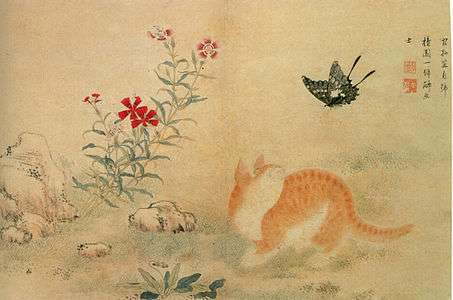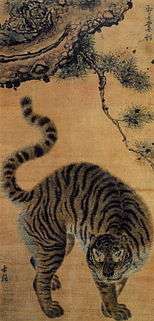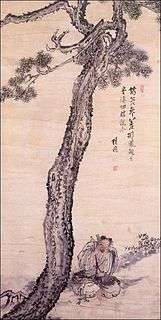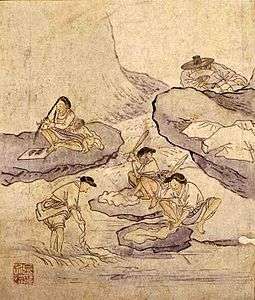Kim Hong-do
| Kim Hong-do | |
 | |
| Korean name | |
|---|---|
| Hangul | 김홍도 |
| Hanja | 金弘道 |
| Revised Romanization | Gim Hong-do |
| McCune–Reischauer | Kim Hongdo |
| Pen name | |
| Hangul | 단원, 단구, 서호, 고면거사, 취화사, or 첩취옹 |
| Hanja | 檀園, 丹邱, 西湖, 高眠居士, 醉畵士, or 輒醉翁 |
| Revised Romanization | Danwon, Dan-gu, Seoho, Gomyeon-geosa, or Cheopchwiong |
| McCune–Reischauer | Tanwŏn, Tan'gu, Sŏho Komyŏn'gŏsa, or Ch'ŏpch'wiong |
| Courtesy name | |
| Hangul | 사능 |
| Hanja | 士能 |
| Revised Romanization | Saneung |
| McCune–Reischauer | Sanŭng |
| Wikimedia Commons has media related to Kim Hong-do. |
Kim Hong-do (김홍도, b. 1745, d. 1806?-1814?), most often styled Danwon (단원), was a full-time painter of the Joseon period of Korea. He was together a pillar of the establishment and a key figure of the new trends of his time, the 'true view painting'. Kim Hong-do was an exceptional artist in every field of traditional painting, even if he is mostly remembered nowadays for his depictions of the everyday life of ordinary people, in a manner analogous to the Dutch Masters.[1]
Short biography
Danwon was a member of the Gimhae Kim clan. He grew up in present-day Ansan, South Korea. At the age of 7, Kim Hong-Do studied under the renowned master Pyoam Kang Se-hwang, who was then living in seclusion in Ansan.[2] In 1766, at the age of 21, on the recommendation of Kang Sehwang,[3] he entered the royal service as a member (hwawon) of the Dohwaseo, the official painters of the Joseon court. In 1771, he painted the portrait of the Royal Heir (the future King Jeongjo). In 1773, he assisted Byeon Sang-byeok when painting the Royal Portrait of King Yeongjo (1694–1724–1776).
In 1776, he painted the "Nineteen Taoist Immortals", that skyrocketed his reputation as a painter. At the same time, the new instated King Jeongjo (1752–1776–1800) commissioned him for many institutional paintings.
He died in loneliness and poverty, though the circumstances, and even the year are unknown. Sources are guessing 1806?,[4] circa 1810,[5] after 1814.[1][3]
Legacy
Danwon is remembered today as one of the "Three Wons," together with Hyewon and Owon. He is also often joined to Owon and the 15th-century painter An Gyeon as one of Joseon's three greatest painters.
The city of Ansan, where he spent his youth and learned his craft, has memorialized him in many ways. The district of Danwon-gu is named after him, as is Ansan's annual "Danwon Art Festival." Many public places have been designed in imitation of his works.
Gallery
Various sources have various opinions about what could be a 'top ten' list for Kim Hong-do.[4][5][6] The most important fact is how successful was Kim Hong-do in all the various types of paintings.
Towooart[7] provides a short notice and an argumented selection of paintings. The Korean Copyright Commission[8] lists 757 paintings, 7 calligraphies and 4 moldings for Kim Hong-do. Remark: some paintings have multiple descriptions (often a sepia version is given with a very fine resolution, and a colorful one with a lower resolution. An example is 평양감사 향안도 Feast for the Pyongyang Governor).
- The paintings that launched the reputation of Kim Hong-do.

Indian Prophet

The Nineteen Taoist Immortals
- 'Literati' paintings.
 ChongSeokJeong
ChongSeokJeong A cat and a butterfly
A cat and a butterfly
Hwangmyonongjeopdo Tiger under a pine tree
Tiger under a pine tree
Songhamaenghodo Drunkard under a tree
Drunkard under a tree
Songhachwisaengdo Tiger underneath a Bamboo
Tiger underneath a Bamboo
Jukhamenghodo
- Official paintings
.jpg)
- The designated painter of the King



- 'Genre paintings'. Among them, the album Danwon pungsokdo provides a serie of 25 paintings. Here are only four of them:
- After 1800 and the death of King Jeongjo.


Fictional portrayals
The novel Painter of the Wind,[9] by Lee Jeong-myeong, is centered on Danwon and Hyewon, who is portrayed as a woman disguised as a man. In 2008, the novel was adapted into a drama series also named Painter of the Wind starring Park Shin-yang (박신양) as Kim Hong-do.[10]
See also
References
- 1 2 Turner 2003, p. (18)53
- ↑ KBS. http://rki.kbs.co.kr/english/program/program_koreanstory_detail.htm??lang=e¤t_page=11&No=23530
- 1 2 Pratt 1999, p. 211
- 1 2 Britannica. http://preview.britannica.co.kr/bol/topic.asp?article_id=b03g2103b (Korean)
- ↑ Chansol 2015
- ↑ TWA 2013
- ↑ KCC 2013
- ↑ Lee Jung-myung (이정명,), Painter of the Wind Vol. 1 & 2, Million House, Seoul, 2007. ISBN 978-89-91643-26-0 & ISBN 978-89-91643-27-7.
- ↑ Mysterious Artist Resurfaces on Modern Culture Scene, Korea Times, 2008-10-09. Retrieved 2010-07-07.
Bibliography
- Pratt, Keith L.; Rutt, Richard; Hoare, James E. (1999). Korea, A Historical and Cultural Dictionary. Durham East Asia Series. Routledge. p. 568. ISBN 978-0-7007-0463-7.
- Turner, Jane (2003). Grove Dictionary of Art. Oxford University Press, US. p. 32600. ISBN 978-0-1951-7068-9.
- Oh, Joosok, Adjunct Professor, Chung-Ang University (2007). "The Life and Art of Kim Hong-do". Korean Art and Archeology. National Museum of Korea. 1: 34–45.
- Chansol (2015). "Danwon Kim Hong-do". Chansol Gallery. Retrieved 2015-09-21. (Korean)
- KCC (2013). "Kim Hong-do". Database. Korean Copyright Commission. (Korean)
- TWA (2013). "Kim Hong-do". Art Database. Towooart. (Korean)
External links
- Arts of Korea, an exhibition catalog from The Metropolitan Museum of Art Libraries (fully available online as PDF), which contains material on Kim Hong-do



